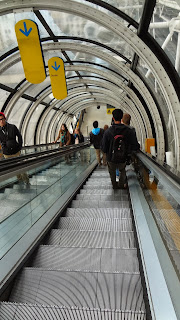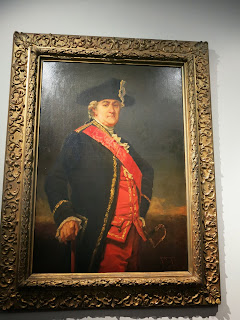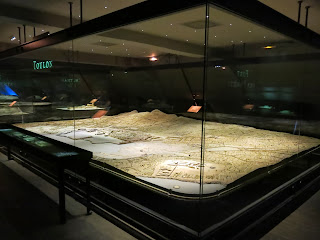My (Sally's) outing did not begin until lunch time, when I went to
Flunch for lunch, adjacent to the Pompedieu Centre. My goal was to see their
collection from 1900-1960. Lunch was a tasty salad (4E 95).
Although I did not find the escalator pretty, it does offer good views of the area on this rainy day.
Sacre Coeur.
There were others that were beautiful and thoughtful. First, my favorite artist from this period- Mark Rothko.
It is always fun to see a Warhol.
I discovered that the 1900-1960 floor was closed. The
options remaining were a retrospective of Roy Lichtenstein and the 1960-present
floors. I am not a big fan of
Lichtenstein- but had already paid my admission- so up I went to the 5th
floor.
The Pompedieu Centre was built during 1977, when it
was popular to expose the pipes, girders, etc. in the building. At the PC, the escalator is inside tubes on
the exterior of the building.
Sacre Coeur.
After seeing the Lichtenstein exhibit, I like his work much
more. Some of his social commentary is
insightful, and some of his works beautiful.
His first famous painting.
I liked the social comment of this painting.
Lichtenstein stated that he based the waves on the works of the Japanese print maker, Hokusai, who drew many pictures of waves.
I liked this painting called "Fishing Village."
There were several paintings which were tributes to famous artists. This one is for Matisse, who painted naked women dancing in a circle.
This is one of his later paintings, which included the dots he used in his early works and were based on newspaper pictures made up of tiny dots, and his interest in Japanese paintings. It is very restful to see.
His first famous painting.
I liked the social comment of this painting.
Lichtenstein stated that he based the waves on the works of the Japanese print maker, Hokusai, who drew many pictures of waves.
I liked this painting called "Fishing Village."
There were several paintings which were tributes to famous artists. This one is for Matisse, who painted naked women dancing in a circle.
This is one of his later paintings, which included the dots he used in his early works and were based on newspaper pictures made up of tiny dots, and his interest in Japanese paintings. It is very restful to see.
Then, downstairs to the 4th floor to see 1960 to
the present. I must admit there are lots
of works in this period I neither like nor understand. Here are 2; there were
many others I did not photograph.
There were others that were beautiful and thoughtful. First, my favorite artist from this period- Mark Rothko.
Another artist, Boetti, created images, gathered 84 colors
of yarn- each color of yarn being the same length- and then gave the images and
yarn it to a group of Afghan refugees to embroider. They were instructed to
fill a canvas with the images using all of the yarn. It is called “everything,” and reminded me of
a crazy quilt- the longer I look at it, the more things I see.


In the evening, we went to a concert at Saint
Chappelle. Saint Chappelle, completed in
1248, was built by Louis IX to house relics he had purchased from a pawn
broker. Baldwin, the emperor in Constantinople, who owned the relics, was a
spendthrift, and pawned them to a pawnbroker in Venice. Louis, motivated by
both piety and a chance to add power to the monarchy, bought them, built a
chapel to house them, and then staged an elaborate journey and ceremony to
install them in the chapel. The Crown of
Thorns has been moved to Notre Dame and is available to see once a month.
The chapel has been described as a jewel box because of the many stained glass
windows, and the sparkle from the sun shining through all of the windows. We were there on a cloudy evening, so did not
experience the sparkle. In addition, all of the windows on the left side were covered by scaffolding.
During the day, Al went to L'Hôtel national des Invalides, more commonly knows as, Les Invalides. This was originally built by Louis the XIV, as a hospital for wounded war veterans. It has been enlarged over the years with more buildings, a chapel and another chapel modeled after St. Peter's Basilica in Rome. Today, it still serves as a hospital for veterans. It also houses the military museum of France and the tombs of Napoleonand other war heroes. The part built after the design of St. Peter's Basilica is now Napoleon's tomb.
The dome is Napoleon's tomb. The low building is still a hospital for veterans.
The buildings behind Napoleon's tomb are a French military museum.
I was surprised at how this World War I tank was so small.
There is a chapel in just behind Napoleon's tomb. The banners hanging in the chapel are enemy banners captured during past wars.
You can see into Napoleon's tomb through the glass behind the alter in the chapel.
This is inside the tomb. You can see into the chapel through the glass behind the crucifix. Napoleon's casket is located below the circular hole in the middle of the picture.
Here it is.
Here is the dome over the casket.
This is a close up of the crucifix with the chapel behind through the glass.
Down at the casket level.
He instituted a code of laws. It is commonly known at the Napoleonic Code, and is still used throughout Europe, parts of the world, and Louisiana.
He centralized the government of France.
Marshall Foch is also here. He was the leader of French and Allied troops during World War I.
A statue of Napoleon II.
As I said, there is also a military museum. There is a very large collection of armor- more than you could possibly want to see.
The armor for Francois I.
I don't know who's armor this is.
Of course, there are more paintings of Napoleon. This is from when he declared himself the Emperor.
This is an original medallion worn by Napoleon.
There was also some art of soldiers. Generally, I don't like war paintings, but I did like these.
On the top floor of the museum they have models of forts and ports that were made in the 19th century. The military commanders used these to plan the defense of the places depicted. They are amazingly detailed and very large. They are topographically accurate and could be used to visualize troop movements and defenses. These are just a few of the ones shown.
On our way home, we went through the Cite metro station. It is an older station with a and Art Nouveau touch. It is a deep station, so there are many stairs. It is all sheet metal and rivet construction. This makes it quite striking. There are street lights on the platform. Because of its depth, it is one of the few Metro stops with an elevator.
During the day, Al went to L'Hôtel national des Invalides, more commonly knows as, Les Invalides. This was originally built by Louis the XIV, as a hospital for wounded war veterans. It has been enlarged over the years with more buildings, a chapel and another chapel modeled after St. Peter's Basilica in Rome. Today, it still serves as a hospital for veterans. It also houses the military museum of France and the tombs of Napoleonand other war heroes. The part built after the design of St. Peter's Basilica is now Napoleon's tomb.
The dome is Napoleon's tomb. The low building is still a hospital for veterans.
The buildings behind Napoleon's tomb are a French military museum.
I was surprised at how this World War I tank was so small.
There is a chapel in just behind Napoleon's tomb. The banners hanging in the chapel are enemy banners captured during past wars.
You can see into Napoleon's tomb through the glass behind the alter in the chapel.
This is inside the tomb. You can see into the chapel through the glass behind the crucifix. Napoleon's casket is located below the circular hole in the middle of the picture.
Here it is.
Here is the dome over the casket.
This is a close up of the crucifix with the chapel behind through the glass.
Down at the casket level.
On the walls around the casket are reliefs depicting accomplishments of Napoleon.
He instituted a code of laws. It is commonly known at the Napoleonic Code, and is still used throughout Europe, parts of the world, and Louisiana.
He centralized the government of France.
Marshall Foch is also here. He was the leader of French and Allied troops during World War I.
A statue of Napoleon II.
As I said, there is also a military museum. There is a very large collection of armor- more than you could possibly want to see.
The armor for Francois I.
I don't know who's armor this is.
Armor for Otto Henrich in 1533.
The military museum is around a courtyard. There is a prominent statue of Napoleon overlooking the courtyard.
There are many paintings of old soldiers. Here are some that were important to our revolution. Sometimes when you look at French military history as depicted in the museum, you might think the French really won our revolution. However, perhaps we don't acknowledge the complete role of the French in our revolution.
Of course, there are more paintings of Napoleon. This is from when he declared himself the Emperor.
This is an original medallion worn by Napoleon.
There was also some art of soldiers. Generally, I don't like war paintings, but I did like these.
On the top floor of the museum they have models of forts and ports that were made in the 19th century. The military commanders used these to plan the defense of the places depicted. They are amazingly detailed and very large. They are topographically accurate and could be used to visualize troop movements and defenses. These are just a few of the ones shown.
We recommend both of these sites.






































































So many beautiful places to visit! We definitely need to go back and spend more time in Paris.
ReplyDelete